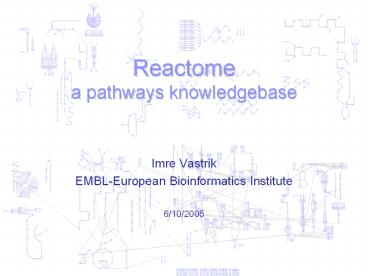Reactome a pathways knowledgebase - PowerPoint PPT Presentation
Title:
Reactome a pathways knowledgebase
Description:
Insulin binds the insulin receptor, causing it to ... Started as Genome Knowledgebase in ... Rules for orthology-based inference. 75% of a complex must have ... – PowerPoint PPT presentation
Number of Views:81
Avg rating:3.0/5.0
Title: Reactome a pathways knowledgebase
1
Reactomea pathways knowledgebase
- Imre Vastrik
- EMBL-European Bioinformatics Institute
- 6/10/2005
2
The Plan
- Why?
- How?
- What does it look like/what can you do with it?
3
From data to knowledge
Decrease in computational access
4
Insulin binds the insulin receptor, causing it
to dimerise. The dimerised form the
autophosphorylates on 6 cytoplasmic tyrosines.
This phosphorylated form recruits the IRS
adaptor....
5
(No Transcript)
6
Decrease in computational access
7
(No Transcript)
8
(No Transcript)
9
- Why?
- How?
- What does it look like/what can you do with it?
10
History of Reactome
- Started as Genome Knowledgebase in spring 2001.
- Aim capture the knowledge of biological experts
in a form that could be searched and reasoned
over electronically, and which could act as a
connecting link between sequence records and
primary biomedical literature. - Initially tried to capture and standardise the
language used to describe molecular processes. - 2001/2002 realised that what we are trying to
capture are reactions and pathways. - Rebranded as Reactome June 2004.
11
Reactome data model
12
Reactome data model
13
Reactome data model
UniProtP01308
PMID8276779 PMID8039601
PMID11737239 PMID8276779 PMID7781591
Insulin signalling
transmembrane receptor protein tyrosine kinase
activity GO0004714
Insulin
Insulin
Insulin
Insulin
extracellular region GO0005576
plasma membrane GO0005886
Insulin receptor
Insulin receptor
Insulin receptor
Insulin receptor
Cytosol GO0005829
P
P
P
P
IRS
IRS-1
IRS-2
DOK1
UniProt Q9Y4H2
UniProt Q99704
UniProt P35568
UniProtP06213
ChEBI2359
ChEBI2342
14
Ambiguity of connection maps
A
B
C
D
Do you need A B or just A B to get active C?
15
is avoided by using states and reactions
A B
A B
C
C
A
A
B
C
B
D
D
C
C
D
D
16
About mice and men
PMID5555
PMID4444
PMID8976
PMID3924
human
mouse
rat
human
17
and how not to mix them
PMID5555
PMID4444
Direct evidence
Direct evidence
human
Indirect evidence
PMID8976
mouse
Indirect evidence
PMID3924
rat
18
Two FAQs
- What about tissue specific reactions?
- We annotate to the union of all possible
reactions gene expression data gives the set of
reactions feasible in a cell - What about fine dynamic balances?
- We only capture qualitative information. The
quantitative/model aspects has to be handled by
ODEs/Kds and SBML like techniques. We can link to
these resources, but they are out of scope for
the moment
19
Reviewer (external)
Curator (staff)
Expert (external)
20
Release cycle
Repository
Extract finished reviewed topics
Computationally project pathways to other
organisms
Add cross-references (Ensembl, Entrez Gene, MIM,
KEGG,)
Release DB
www.reactome.org
21
Reactome in numbers(release 15, 26/9/2005)
- Human
- Reactions 1524
- Pathways 659
- Proteins 1095
- Small molecules 379
- Complexes 982
- Literature references 1408
- Interactions 19471
22
- Why?
- How?
- What does it look like/what can you do with it?
23
HSA
Homo sapiens
MMU
Mus musculus
TNI
Tetraodon nigroviridis
DME
Drosophila melanogaster
CEL
Caenorhabditis elegans
SCE
Saccharomyces cerevisiae
ANI
Aspergillus nidulans
SPO
Schizosaccharomyces pombe
ATH
Arabidopsis thaliana
DDI
Dictyostelium discoideum
PFA
Plasmodium falciparum
MJA
Methanococcus jannaschii
SSO
Sulpholobus solfataricus
ECO
Escherichia coli
BSU
Bacillus subtilis
ANA
Anabaena
24
Rules for orthology-based inference
- 75 of a complex must have orthologs
- Lineage specific paralogs are allowed
- All small molecules presumed to exist if
reactions exist - Otherwise every input, output, catalyst must be
present
25
Finding lineage-specific deletions
HSA
MMU
TNI
DME
CEL
SCE
ANI
SPO
ATH
DDI
PFA
MJA
SSO
ECO
BSU
ANA
26
Lineage-specific deletion rates
27
Absent in cerevisiae and pombe, but present in
aspergillus
Lipid metabolism
Metabolism of amino acids
Nucleotide metabolism (transport)
Xenobiotic metabolism
28
Lineage Deletion rates
29
Presence of small molecules
30
Tissue expression
more correlated
Data from Human Novartis Affy scan
31
Reactome at a glance
- Catalogue of all possible reactions (topology) in
an organism - reactome - Authored by experts
- Currently human orientated
- Computational predictions to other species
- Data code freely available (www.reactome.org/dow
nload) - MySQL database, SBML, BioPAX specialised
datasets - Perl and Java APIs
- Website mirror
- Data entry tool
32
Groups People
www http//www.reactome.org e-mail help_at_reactom
e.org
NHGRI Grant R01 HG002639 EU STREP EMI-CD EBI
Industry program































